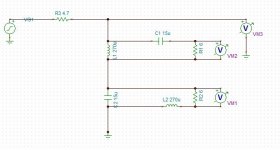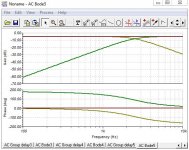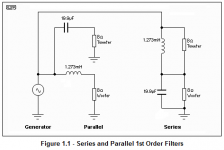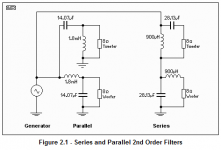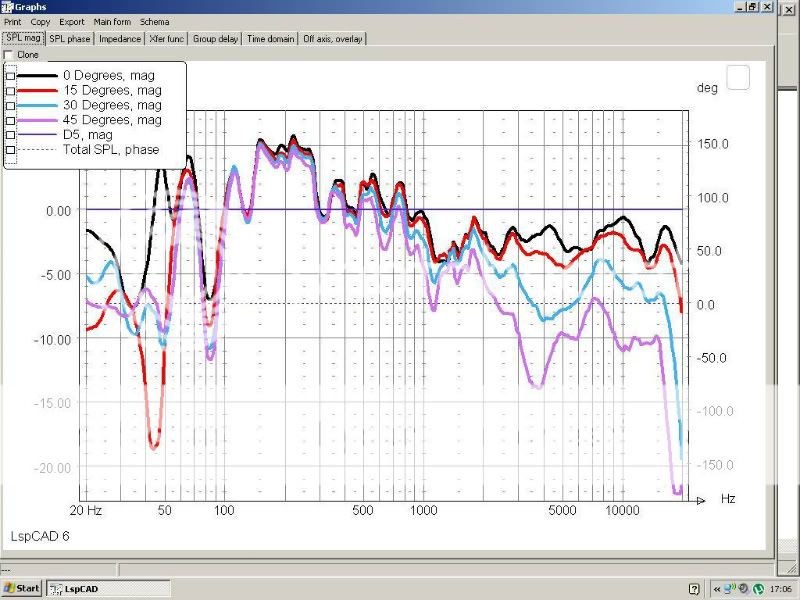I think something like 2khz secoond order would be a good starting point if you are happy to try a parallel crossover. The waveguide should hold directivity that low, and the woofer isn't beaming too badly there (atleast from what I see in the datasheet).
Off-axis measurement atleast at 30 and 60 degrees will be needed to get a good match and will also give a better picture whats going on with the current setup.
I would do as Shaun says, set up the target curve and try to match it. LspCAD allows you to do this.
Off-axis measurement atleast at 30 and 60 degrees will be needed to get a good match and will also give a better picture whats going on with the current setup.
I would do as Shaun says, set up the target curve and try to match it. LspCAD allows you to do this.
I think something like 2khz secoond order would be a good starting point if you are happy to try a parallel crossover. The waveguide should hold directivity that low, and the woofer isn't beaming too badly there (atleast from what I see in the datasheet).
Off-axis measurement atleast at 30 and 60 degrees will be needed to get a good match and will also give a better picture whats going on with the current setup.
I would do as Shaun says, set up the target curve and try to match it. LspCAD allows you to do this.
I did try quite a few parallel, second-order crossovers before trying the AR-SXO, but they were always a bit dull. Vocals weren't alive and didn't project like the AR crossover.
I'll try to set-up a target curve and see what happens.
Here's the crossover:
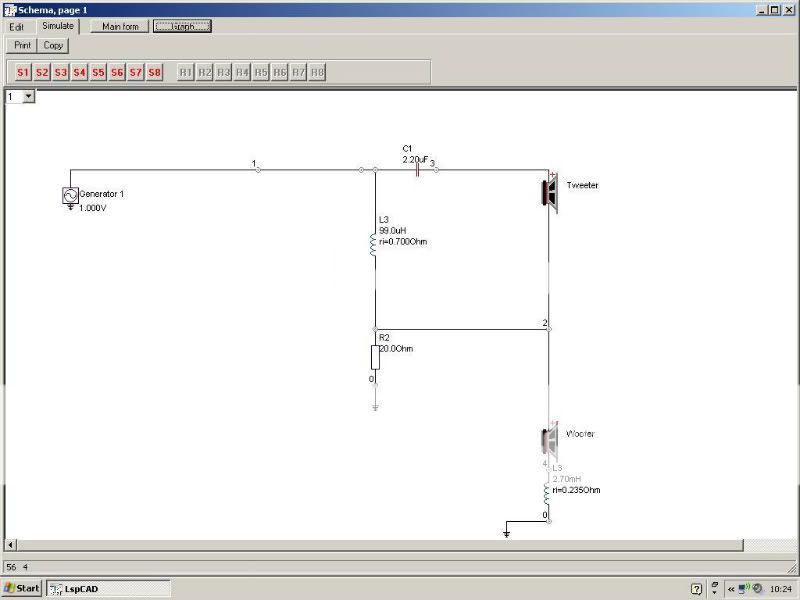
You do seem to have departed quite a lot from Acoustic Reality's design there. Bigger bafflestep coil, higher resistance value and perhaps too small a coil in front of the (Le=100uH?) tweeter. The extra, smallish 2.2uF capacitor is going to affect damping a lot too. I wonder what the impedance looks like?
AR-SXO - Acoustic Reality - Designed and built in Denmark
I also wonder if Ben Shaffer's 2nd order design might be better for what you are actually doing:
Tips! Volume 3, Section B.. Series Xovers.... - Techtalk Speaker Building, Audio, Video, and Electronics Customer Discussion Forum From Parts-Express.com
Or you work with Rod Elliott's 1st or 2nd order butterworth slopes, which are constant resistance and allow you to separate out the bafflestep correction as a series LR circuit before the crossover without affecting the Q.
Series vs. Parallel Crossover Networks
No particular recommendation here, just ideas for your modelling.
Last edited:
You do seem to have departed quite a lot from Acoustic Reality's design there. Bigger bafflestep coil, higher resistance value and perhaps too small a coil in front of the (Le=100uH?) tweeter. The extra, smallish 2.2uF capacitor is going to affect damping a lot too. I wonder what the impedance looks like?
AR-SXO - Acoustic Reality - Designed and built in Denmark
I also wonder if Ben Shaffer's 2nd order design might be better for what you are actually doing:
Tips! Volume 3, Section B.. Series Xovers.... - Techtalk Speaker Building, Audio, Video, and Electronics Customer Discussion Forum From Parts-Express.com
Or you work with Rod Elliott's 1st or 2nd order butterworth slopes, which are constant resistance and allow you to separate out the bafflestep correction as a series LR circuit before the crossover without affecting the Q.
Series vs. Parallel Crossover Networks
No particular recommendation here, just ideas for your modelling.
Here's the impedance:
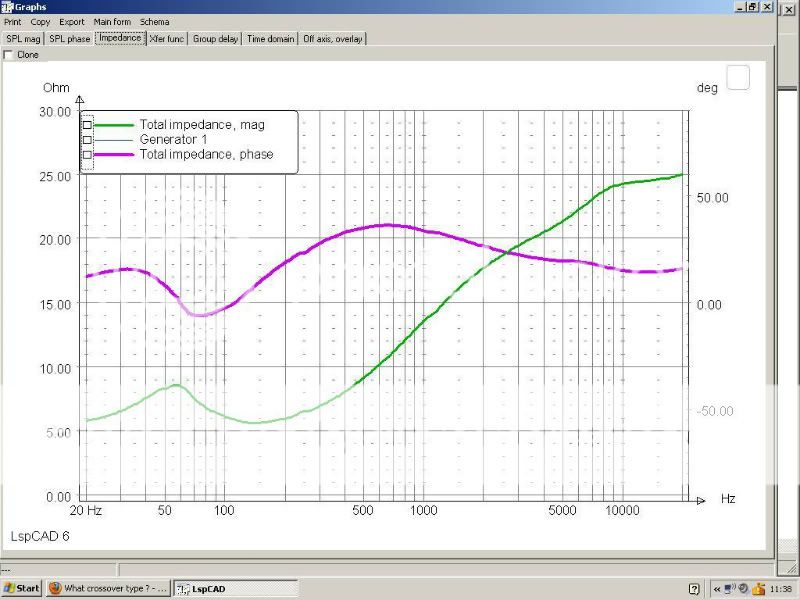
Cheers for the links. I'll have a look at those...
HaHa, I mean this in the nicest way, but that's a bit of a horror really, isn't it?Here's the impedance:

...snip
Something going badly wrong at high frequencies...
I've thoroughly read that Troels stuff on the DT-300 in the past, and it looks OK for a simple first order crossover. Vifa C17WH-
The conventional wisdom on series crossovers is you need to use an RC Zobel (say, 8 ohms and 10uF) at least across the woofer, and pad out the tweeter for a flattish impedance. It's quite hard to find out the inductance of the tweeter, but Troels has given the LCR Fs circuit anyway.
I suspect that highish 0.9mH woofer impedance is going to be a pain, but here's hoping.
Is SpeakerWorkshop easy to use?
Yes and no. The difficult part is usually getting the measurements working right. Besides that, working through the example in the help file will get you going in no time. It's not the most intuitive program but, once you get to know your way around it, it's a breeze.
HaHa, I mean this in the nicest way, but that's a bit of a horror really, isn't it?
Something going badly wrong at high frequencies...
I've thoroughly read that Troels stuff on the DT-300 in the past, and it looks OK for a simple first order crossover. Vifa C17WH-
The conventional wisdom on series crossovers is you need to use an RC Zobel (say, 8 ohms and 10uF) at least across the woofer, and pad out the tweeter for a flattish impedance. It's quite hard to find out the inductance of the tweeter, but Troels has given the LCR Fs circuit anyway.
I suspect that highish 0.9mH woofer impedance is going to be a pain, but here's hoping.
Yea, it's not looking great on paper, but I don't know how it effects things in reality. Could it be the cause of the rough sound?
To be honest, i'm not sure I want to waste too much time or money on this build because i've decided i'd like to build a 3-way and this enclosure is the perfect size for my new build.
It took a long time to get an acceptable sound from my current speakers, but from what i've learnt, I think I should be able to get there a lot quicker now (getting the BSC right was what wasted the most time).
Yes and no. The difficult part is usually getting the measurements working right. Besides that, working through the example in the help file will get you going in no time. It's not the most intuitive program but, once you get to know your way around it, it's a breeze.
Cheers. I'll have to think about it...
You sound like you're getting into a sulk about this, fatmarley. You shouldn't. 
I've already said your crossover point is too high. You need to be around 2.7kHz. I think that AR-SXO is too purist for what you are trying to do as well. It needs particular drivers to stand a hope in hell of working.
A first or second order LC series circuit is more promising.
Series vs. Parallel Crossover Networks
You need to be familiar with BSC RL circuits:
Loudspeaker Diffraction Loss and Baffle Step Compensation Circuits
And driver impedance equalisation:
Speaker Zobel / Impedance Equalization Network Circuit Calculator
Here's some modelling I did in TINA-TI which is a free download. The crucial thing to keep track of is the L/C ratio (here 270/15=18) , which is half R squared (36) for butterworth second order curves. You can do Linkwitz-Riley by halving the capacitor value too, but that is not constant resistance and changes the crossover point. The LC ratio relates to the crossover frequency. Because your woofer is high at 900uH, you probably need a Zobel, otherwise you could use the woofer inductance as the second (L2) component in the bass crossover.
I've already said your crossover point is too high. You need to be around 2.7kHz. I think that AR-SXO is too purist for what you are trying to do as well. It needs particular drivers to stand a hope in hell of working.
A first or second order LC series circuit is more promising.
Series vs. Parallel Crossover Networks
You need to be familiar with BSC RL circuits:
Loudspeaker Diffraction Loss and Baffle Step Compensation Circuits
And driver impedance equalisation:
Speaker Zobel / Impedance Equalization Network Circuit Calculator
Here's some modelling I did in TINA-TI which is a free download. The crucial thing to keep track of is the L/C ratio (here 270/15=18) , which is half R squared (36) for butterworth second order curves. You can do Linkwitz-Riley by halving the capacitor value too, but that is not constant resistance and changes the crossover point. The LC ratio relates to the crossover frequency. Because your woofer is high at 900uH, you probably need a Zobel, otherwise you could use the woofer inductance as the second (L2) component in the bass crossover.
Attachments
Sulk! me! 
I was serious about building some 3-way speakers (a case of running before you can walk), but not because i'm not happy with these. I just want more of everything.
Thank's for the links - I didn't realize you could get a BSC calculator. if I have the parts, I may try another crossover (I am curious to see if the crossover can be bettered). I know the crossover point is far too high (in theory) , but it sounds pretty good and much, much better than the second-order electrical (woofer and tweeter), parallel crossover I tried before (phase tracking was very good and I had a nice big null at the crossover point).
Regarding the BSC calculator that you left a link too. For some reason it was miles out compared to what I came up with by ear (1.7mH vs 2.7mH). I'll measure the Re of the driver and see what it looks like then.
I really do appreciate any advice and will post all the details of my 3-way build when I start it.
I was serious about building some 3-way speakers (a case of running before you can walk), but not because i'm not happy with these. I just want more of everything.
Thank's for the links - I didn't realize you could get a BSC calculator. if I have the parts, I may try another crossover (I am curious to see if the crossover can be bettered). I know the crossover point is far too high (in theory) , but it sounds pretty good and much, much better than the second-order electrical (woofer and tweeter), parallel crossover I tried before (phase tracking was very good and I had a nice big null at the crossover point).
Regarding the BSC calculator that you left a link too. For some reason it was miles out compared to what I came up with by ear (1.7mH vs 2.7mH). I'll measure the Re of the driver and see what it looks like then.
I really do appreciate any advice and will post all the details of my 3-way build when I start it.
Last edited:
Truth was that Troels made a hash of that particular design. He was still fiddling with it himself up to version 8 crossover to stop it sounding rough at high volume! Vifa C17WH- 
Taking out the ferrofluid is NOT what you do with low order crossovers of either variety. Raises the Q on the Fs and lets too much bass into the tweeter. Seemples.
Taking out the ferrofluid is NOT what you do with low order crossovers of either variety. Raises the Q on the Fs and lets too much bass into the tweeter. Seemples.
I may try another crossover (I am curious to see if the crossover can be bettered).
Why not take some reflection free measurements of your speakers in their boxes and forget about BSC. Collecting the right data is the key to the next level of crossover.
Truth was that Troels made a hash of that particular design. He was still fiddling with it himself up to version 8 crossover to stop it sounding rough at high volume! Vifa C17WH-
Taking out the ferrofluid is NOT what you do with low order crossovers of either variety. Raises the Q on the Fs and lets too much bass into the tweeter. Seemples.
Sorry for the delay in replying. I've been away for a few days.
I do have some standard Monacor DT-300s that I could try, but i'm not really stressing them with the crossover point i'm using (compared to Troels). So i'm not sure it's worth bothering.
Why not take some reflection free measurements of your speakers in their boxes and forget about BSC. Collecting the right data is the key to the next level of crossover.
I've taken loads of reflection-free measurements of the drivers in the box, over the last year. The ones I posted in this thread are the best of the bunch.
Yea, it's not looking great on paper, but I don't know how it effects things in reality. Could it be the cause of the rough sound?
Your impedance curve is perfectly natural for that network. The lowest impedance path for high frequencies is through the tweeter and then through the 20 ohms, hence the climb to 25 ohms. Its not a classic impedance curve, but amplifiers are generally very happy with inductive rises. I wouldn't worry about it if the frequency response is good. If you think the sound is rough then apparently the response is not good. Your best bet would be to see how component value variation impacts the simulated model and see if you can find a good way to impact upper and lower treble levels, then make the changes and see if any combination is too your liking.
David
At several angles? It appears at first glance that this speaker will give a less predictable in room response when crossed above maybe 2kHz. Especially dependent on how you place them.I've taken loads of reflection-free measurements of the drivers in the box,
Your impedance curve is perfectly natural for that network. The lowest impedance path for high frequencies is through the tweeter and then through the 20 ohms, hence the climb to 25 ohms. Its not a classic impedance curve, but amplifiers are generally very happy with inductive rises. I wouldn't worry about it if the frequency response is good. If you think the sound is rough then apparently the response is not good. Your best bet would be to see how component value variation impacts the simulated model and see if you can find a good way to impact upper and lower treble levels, then make the changes and see if any combination is too your liking.
David
Glad to hear the impedance curve is ok.
I'm now starting to think the rough sound is caused by my ears! The tv was sounding a bit rough at the same time my hifi was. My ears were a bit sore inside, but are fine now and everything sounds fine too.
At several angles? It appears at first glance that this speaker will give a less predictable in room response when crossed above maybe 2kHz. Especially dependent on how you place them.
I did take some at different angles, but not with the crossover connected. I'd be curious to know what the frequency response looks like at various angles, so may give it a try when I next get the measuring gear out.
- Status
- This old topic is closed. If you want to reopen this topic, contact a moderator using the "Report Post" button.
- Home
- Loudspeakers
- Multi-Way
- What crossover type ?
